The chemical makeup of Earth’s atmosphere is said to contain about 78% Nitrogen and 21% oxygen, with argon, carbon dioxide, and other gases making up the remaining 1%.
But an international team of scientists says they have detected vapors of iron and titanium in the atmosphere of what is considered to be the hottest “ultra-hot” Jupiter-like planet found so far.
Led by the University of Geneva, Switzerland and the University of Bern, Germany, the scientists say they were able to detect the metals in the atmosphere because of the planet’s incredibly hot surface temperature.
Discovered last year, the exoplanet, KELT-9b, is said to have a dayside temperature of between 3,800° and 4,300° Celsius.
At that temperature range, the exoplanet’s dayside surface temperature is essentially hotter than the surface of many stars.
That would make it only about 1,200° Celsius cooler than our Sun’s visible surface (5,504.85° Celsius)
It’s thought that the planet is tidally locked with its star, which means only one side of this exoplanet is always exposed, bearing the brunt of the scorching hot temperatures.
The star, known as KELT-9, is considered to be a massive A-type star, with a surface temperature of about 10,000° Celsius.
KELT-9 is located about 650 light years from Earth and can be found in the constellation, Cygnus.
The “ultra-hot” Jupiter-like exoplanet is thought to orbit its sun every 36 hours.
Along with the star’s blazing surface temperature, the scientists say they think the exoplanet is so hot because it orbits from a distance of a little over 5 million kilometers which is about 30 times closer than the Earth is to the Sun (around 148,059,648 kilometers).
The scientists outlined their findings in a recent study that was published in the journal, Nature.























Comments are closed.